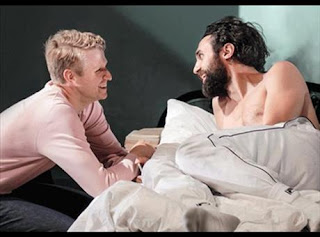Theater Review: History of Violence pungently explores sex and race.
History of Violence
Written by Édouard Louis
Directed by Thomas Ostermeier
Starring Laurenz Laufenberg
schaubühne berlin
St. Ann’s Warehouse, Brooklyn NY
November 14, 2019
This excellent, jarring play was adapted from a memoir/novel
by French author Édouard Louis in 2016 by Thomas Ostermeier, the author and
company director of the modernist German company schaubühne berlin. It made for quite
a multinational evening…a French book portrayed in German by a multinational
cast, done in a Brooklyn theater. The German text was translated with supertitles
on a screen behind the actors which, common to many modern plays, served a
major role in the production via many handheld camera projections. The play was
an excellent commentary on both modern sexuality (not really so modern as it
turns out) and class/racism in Western countries, and did so with a visceral,
immediate fusion that made me reflect more than most such plays with political
points to make. The memoir/novel stemmed from the personal experiences of Mr.
Louis, a young gay author who was sexually assaulted in Paris by a North
African man after they first hooked up for a night of consensual sex. The text
fully explores the conflicting emotions of the young, horny Édouard,
with upper class guilt over French exploitation of underclass emigrants, then
mixed in with his terror after the perfect evening of sex and class
equalization with the hunky Reda turns very bad. The play artfully begins with just
the horror—in the opening scene we see the thin, blonde Édouard (an outstanding,
multilayered Laurenz Laufenberg) cowering in the corner as three crime lab
technicians clad in space-suit appearing garb minutely go over his apartment
for clues. This was the first use of handheld cameras in the play, showing ultra-zoom
close shots of the fibers and fingerprints on his floor, all projected on the
backstage screen, making the opening feel less like a human drama than a creepy
science experiment. The play evolves so that we first see Édouard’s
halting testimonies about the assault, but something seems missing. There is
certainly the fear and guilt often seen in rape victims, but also an odd ambivalence
in his initial testimony to the officious cold policemen. As the play goes on,
we learn more about the actual backstory, including the protagonist’s
innocence, attraction to darker skinned men, and charming seduction on the
streets of Paris. To the credit of the author, no easy answers are provided.
Was this criminal violence, an unfortunate extension of male sexuality, a
repressed class/race conflict, or (likely) a mixture of all three? How should
the victim see himself and society after such an experience? The author avoids
the traps most American authors fall into of either creating a dramatic
conclusion that gives the viewer an “answer” or engaging in speechifying and
hitting us over the head with his/her philosophy. Instead, Mr. Louis allows us
to form our own conclusions. I appreciated that.
The play was set on a mostly blank, black set except for the
video screen in back. At times the six actors used microphones, often to
amplify intimate discussion (as in during sex) but sometimes for no apparent
reason. The handheld cameras were excellent, and used with real purpose. For
example, when Édouard talks about showering after the assault to rinse
every bit of his assailant’s skin and smell off of his body, the camera clinically
(not erotically) panned over every inch of his naked body as he showered on stage.
The addition of high-tech video and audio effects now seems standard in modern
theater, but as always, the best directors do not just use it for glitz or
showmanship, but for a true dramatic purpose. The German actors were uniformly
fine, some playing multiple roles. I thought the interaction between Édouard
and Reda were convincing, mixing lust, tenderness, fear, and awkwardness in the
proportions often seen in first-time sex, but rarely shown so convincingly on
stage or screen. The physical types of the two actors helped there, as Édouard
thin, waiflike and blonde, while Reda was muscular, tall, and bearded. There
was nudity (pre-theater safe space warnings!), but no explicit sex, as the
author chose to have us use our imaginations there.
Overall, this play had provocative shock value in making me
think about sex, maleness, violence, class, and race. It was more potent than
the similarly conceived The Slave Play, now on Broadway. Both plays used
sex as an avenue to discuss power, race and class, but this seemed more
gimmicky in the American play, which shocks with sex, then degenerates into a
ruminative philosophical talkfest. Perhaps the most comparable play I have seen
in terms of examining sex vs. violence was Bleach, in which the intimacy
and immediacy was conveyed by our being 2-3 feet from the assaulted young male
callboy in a tiny Brooklyn apartment “theater”. That History of Violence
could achieve a similar visceral punch in a big theater is a credit to the
author, director, and actors, and to perhaps the best use of modern AV
technology I have thus seen on the stage.


Comments
Post a Comment